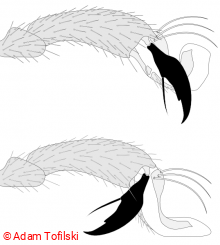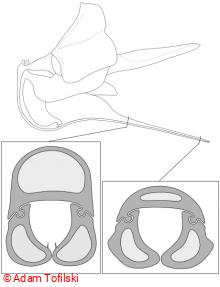
Part of fore wing of honey bee worker used for measurements of cubital index. (scale bar = 1 mm)
The cubital index was used, mainly by beekeepers, to discriminate honey bee subspecies. The discrimination using cubital index is relatively imprecise because it is based on measurements of only two distances The limitations of biometric control on pure race breeding in Apis mellifera,
, Volume 30, Number 2, p.54–59, (1991)
[1]Biometrical control of breeding,
, Volume 30, Issue 2, Number 2, p.113-114, (1991)
[2]. More precise methods of subspecies discrimination require large number of measurements Biogeography and taxonomy of honeybees,
, Berlin, (1988)
[3]Using geometric morphometrics and standard morphometry to discriminate three honeybee subspecies,
, Volume 39, Number 5, p.558–563, (2008)
[4].
Selection for high cubital index by A. m. carnica breeders in Germany lead to unusually high cubital index in commercially available breeding lines of this subspecies Biometrical control of breeding,
, Volume 30, Issue 2, Number 2, p.113-114, (1991)
[2]. There are various methods of measuring cubital index Operation rate and sensitivity of devices used for determining cubital index value,
, Volume 46, Number 2, p.35, (2002)
[5].
There are many conflicting definitions of cubital index. Probably this term was used for the first time by Alpatov Porody medonosnoi pchely,
, Moskva, p.168, (1948)
[6]. Cubital index according to Alpatov (CIAlpatov) is expressed in percent:
CIAlpatov = 100 dAB/dBC
where:
dAB - distance between points A and B
dBC - distance between points B and C
Cubital index according to Goetze (CIGoetze1) Die Bedeutung des Flügelgeaders für züchterische Beuerteilung der Honigbiene,
, Volume 4, Number 7, p.141–148, (1959)
[7] is:
CIGoetze1 = dbC/dAb
where:
dbC - distance between points b and C
dAb - distance between points A and b
Goetze Die Bedeutung des Flügelgeaders für züchterische Beuerteilung der Honigbiene,
, Volume 4, Number 7, p.141–148, (1959)
[7] introduced also another variation of this index called "realer Cubital Index" (CIGoetze2):
CIGoetze2 = dBC/dAB
The last definition was generally accepted in Western Europe, while in Eastern Europe definition of Alpatov was used.
Conversion of the two variation of the cubital index:
CIAlpatov = 100/CIGoetze
CIGoetze = 100/CIAlpatov
In book of Ruttner Biogeography and taxonomy of honeybees,
, Berlin, (1988)
[3] (an important source of information about honey bee measurements) there is an error in description of cubital index - in figure 4.7 Biogeography and taxonomy of honeybees,
, Berlin, (1988)
[3] - points B and C are swapped.
Cubital index of workers from species of genus Apis:
- A. cerana 3.98 (Ruttner 1988, Tab. 1.1) Biogeography and taxonomy of honeybees,
, Berlin, (1988)
[3], 2.63 - 7.86 (Ruttner 1988, Tab. 9.5) Biogeography and taxonomy of honeybees,
, Berlin, (1988)
[3] - A. dorsata 7.25 (Ruttner 1988, Tab. 1.1) Biogeography and taxonomy of honeybees,
, Berlin, (1988)
[3] - A. florea 2.82 (Ruttner 1988, Tab. 1.1) Biogeography and taxonomy of honeybees,
, Berlin, (1988)
[3] - A. mellifera 1.53 - 3.60 (Ruttner 1988, Tab. 4.1) Biogeography and taxonomy of honeybees,
, Berlin, (1988)
[3].
Cubital index ±SD of workers from subspecies of A. mellifera:
- A. m. adami 1.89±0.18 (Ruttner 1988, Tab. 11.1) Biogeography and taxonomy of honeybees,
, Berlin, (1988)
[3] - A. m. adansonii 2.39±0.41 (Ruttner 1988, Tab. 12.2) Biogeography and taxonomy of honeybees,
, Berlin, (1988)
[3] - A. m. armeniaca 2.61±0.42 (Ruttner 1988, Tab. 11.1) Biogeography and taxonomy of honeybees,
, Berlin, (1988)
[3] - A. m. anatoliaca 2.24±0.18 (Ruttner 1988, Tab. 11.1) Biogeography and taxonomy of honeybees,
, Berlin, (1988)
[3] - A. m. capensis 2.33±0.34 (Ruttner 1988, Tab. 12.2) Biogeography and taxonomy of honeybees,
, Berlin, (1988)
[3] - A. m. carnica 2.59±0.42 (Ruttner 1988, Tab. 14.1), 2.51 - 2.86 (Ruttner 1988, Tab. 14.2) Biogeography and taxonomy of honeybees,
, Berlin, (1988)
[3], 2.94 in some commercial breeding lines Biometrical control of breeding,
, Volume 30, Issue 2, Number 2, p.113-114, (1991)
[2]. - A. m. caucasia 2.16±0.31 (Ruttner 1988, Tab. 11.1) Biogeography and taxonomy of honeybees,
, Berlin, (1988)
[3] - A. m. cecropia 3.11±0.57 (Ruttner 1988, Tab. 14.1) Biogeography and taxonomy of honeybees,
, Berlin, (1988)
[3] - A. m. cypria 2.72±0.36 (Ruttner 1988, Tab. 11.1) Biogeography and taxonomy of honeybees,
, Berlin, (1988)
[3] - A. m. iberiensis 1.84±0.27 (Ruttner 1988, Tab. 13.1) Biogeography and taxonomy of honeybees,
, Berlin, (1988)
[3] - A. m. intermissa 2.33±0.36 (Ruttner 1988, Tab. 13.1) Biogeography and taxonomy of honeybees,
, Berlin, (1988)
[3], 2.25±0.10 Apis mellifera ruttneri, a new honey bee subspecies from Malta,
, Volume 28, Number 5, p.287–293, (1997)
[8] - A. m. lamarckii 2.37±0.37 (Ruttner 1988, Tab. 12.2) Biogeography and taxonomy of honeybees,
, Berlin, (1988)
[3] - A. m. ligustica 2.55±0.41 (Ruttner 1988, Tab. 14.1) Biogeography and taxonomy of honeybees,
, Berlin, (1988)
[3], 2.54±0.15 Apis mellifera ruttneri, a new honey bee subspecies from Malta,
, Volume 28, Number 5, p.287–293, (1997)
[8] - A. m. litorea 2.25±0.41 (Ruttner 1988, Tab. 12.2) Biogeography and taxonomy of honeybees,
, Berlin, (1988)
[3] - A. m. macedonica 2.59±0.41 (Ruttner 1988, Tab. 14.1) Biogeography and taxonomy of honeybees,
, Berlin, (1988)
[3] - A. m. mellifera 1.84±0.28 (Ruttner 1988, Tab. 13.1) Biogeography and taxonomy of honeybees,
, Berlin, (1988)
[3] - A. m. meda 2.56±0.72 (Ruttner 1988, Tab. 11.1) Biogeography and taxonomy of honeybees,
, Berlin, (1988)
[3] - A. m. monticola 2.35±0.41 (Ruttner 1988, Tab. 12.2) Biogeography and taxonomy of honeybees,
, Berlin, (1988)
[3] - A. m. ruttneri 2.41±0.24 Apis mellifera ruttneri, a new honey bee subspecies from Malta,
, Volume 28, Number 5, p.287–293, (1997)
[8] - A. m. sahariensis 2.62±0.41 (Ruttner 1988, Tab. 13.1) Biogeography and taxonomy of honeybees,
, Berlin, (1988)
[3] - A. m. scutellata 2.52±0.46 (Ruttner 1988, Tab. 12.2) Biogeography and taxonomy of honeybees,
, Berlin, (1988)
[3] - A. m. siciliana 2.47±0.42 (Ruttner 1988, Tab. 14.1) Biogeography and taxonomy of honeybees,
, Berlin, (1988)
[3], 2.42±0.24 Apis mellifera ruttneri, a new honey bee subspecies from Malta,
, Volume 28, Number 5, p.287–293, (1997)
[8] - A. m. simensis 2.24±0.20 (Meixner et al. 2011, Tab. 3) The honey bees of Ethiopia represent a new subspecies of Apis mellifera - Apis mellifera simensis n. ssp.,
, Volume 42, Number 3, p.425–437, (2011)
[9] - A. m. syriaca 2.28±0.37 (Ruttner 1988, Tab. 11.1) Biogeography and taxonomy of honeybees,
, Berlin, (1988)
[3] - A. m. unicolor 2.79±0.42 (Ruttner 1988, Tab. 12.2) Biogeography and taxonomy of honeybees,
, Berlin, (1988)
[3] - A. m. jemenitica 2.20±0.40 (Ruttner 1988, Tab. 12.2), 2.20 - 2.45 (Ruttner 1988, Tab. 12.3) Biogeography and taxonomy of honeybees,
, Berlin, (1988)
[3]
Cubital index differs between queens, workers and drones. In honey bee drones cubital index ranges from 1.38 to 1.93 (Ruttner 1988, Tab. 11.4) Biogeography and taxonomy of honeybees,
, Berlin, (1988)
[3].
Cubital index is not very effective in identification of honey bee subspecies Conservation of the dark bee (Apis mellifera mellifera): Estimating C-lineage introgression in Nordic breeding stocks,
, (2020)
[10].
- Log in to post comments
- Log in to post comments





